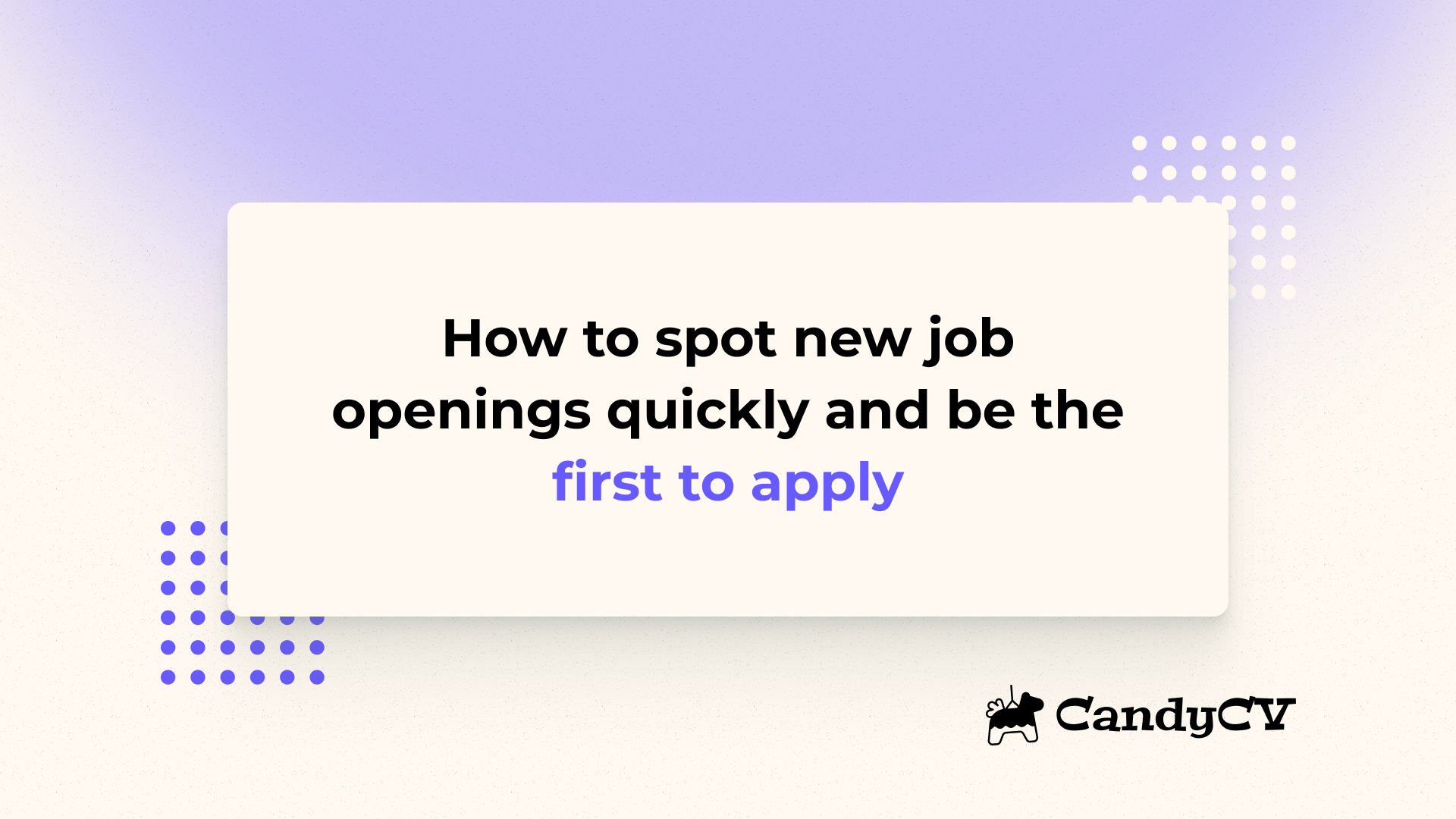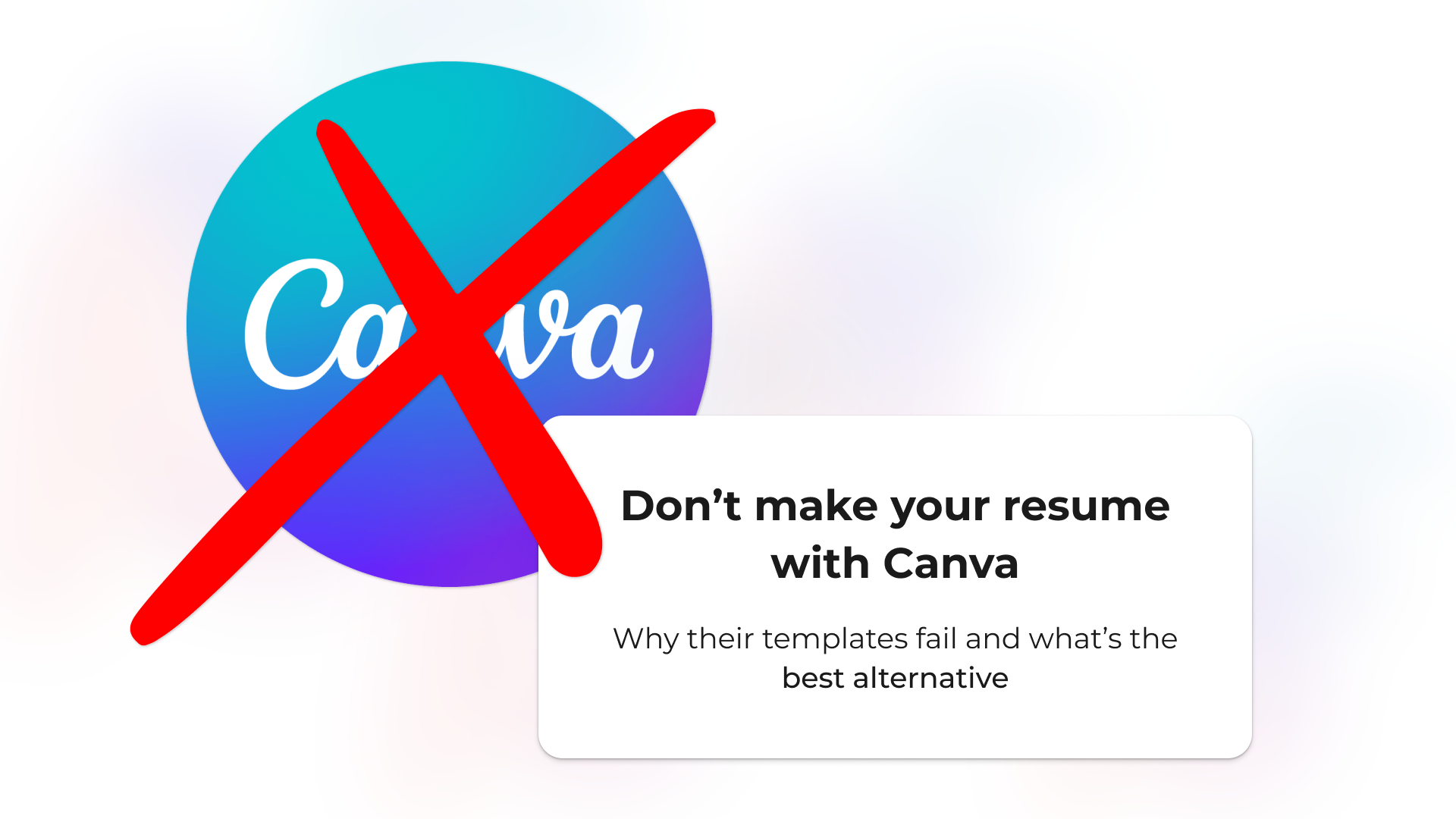
Don’t make your resume with Canva: why its templates fail and what to use instead
If you’re job hunting, chances are you’ve come across Canva’s resume templates. This platform has won over millions thanks to its versatile and visually appealing design tools. So making a resume in Canva seems like the perfect solution to get a professional, modern, and effective CV without needing to be a designer.
But the reality is very different. Canva is fantastic for creating visual content like social media posts, invitations, or ads, but it’s not designed for professional text-based documents with specific technical requirements like a resume.
Even if a Canva-made resume looks great (and you’ve probably spent hours perfecting it), there’s a real risk it will never reach a recruiter’s hands.
In this article, I’ll walk you through:
- Why you should avoid making your resume with Canva.
- The technical issues with Canva resume templates that affect your chances.
- What recruiters and HR experts think about Canva resumes.
- The best alternative to create a professional, modern, ATS-friendly resume that’s free and super easy to use.
Problems with Canva resume templates you need to know
Canva resume templates aren’t ATS-friendly
Applicant Tracking Systems (ATS) are programs that automatically filter thousands of resumes to make recruiters’ work easier. Today, most medium and large companies use some form of ATS.
There are different types of ATS, depending on the technology they use, but in general these systems scan your resume for keywords, relevant experience, and skills based on the job posting. If your resume doesn’t pass this initial technical filter, it doesn’t necessarily mean you’re instantly rejected, but it does mean your application will be buried in a pile. Recruiters will first look at the resumes the system can read and interpret correctly.
That makes ATS a major first barrier to landing interviews. And here’s the problem: the vast majority of Canva resume templates are not designed to pass this technical test. If the ATS can’t interpret your resume, all your effort making it look nice will have been for nothing.
Why Canva resumes usually fail ATS scans
Canva resume templates are popular for their style, but they hide pitfalls most people don’t know about:
-
Complex formatting and layout: the problem isn’t using two columns (that's a myth), it’s that Canva often uses separate text boxes and custom headers that make it harder for ATS to read. This creates a messy data structure that can lead to information being misread or ignored entirely.
-
Incompatible graphic elements: icons, progress bars, stars, tables and other visual features are “noise” for ATS. These systems can’t extract text from images, so any information shown as graphics (such as skills level) won’t be recognized.
-
Non-standard fonts and formatting: Canva often uses decorative or script fonts, plus formats like underlined text, which make automated reading even harder. Always use recruiter-approved fonts for ATS-friendly resumes.
-
PDF issues: while Canva lets you download your resume as a PDF, it’s crucial that it’s a text-based PDF, not an image. Otherwise, the ATS won’t be able to extract your information.
In short: you could spend hours (and plenty of frustration) designing a beautiful resume, but if an automated system can’t read it, it’s as good as invisible to many employers.
Limited space for the content that really matters
Many Canva resume templates force you to compress your work experience so much that it becomes unreadable for a recruiter. This happens because the design leaves very little room for text, meaning you either leave out important information or end up with an overly long resume no one will read.
An effective resume needs to clearly and fully tell the story of who you are and what you’ve achieved. But with Canva templates, text has to fit into pre-set, rigid spaces; making it harder to write strong content (without spending hours moving blocks around or shrinking the font until it’s tiny).
Imagine trying to explain your most important project, but only having two lines to do it. Do you think that conveys the full value? Templates that prioritize visuals over substance often give you a weak resume that doesn’t reflect your true potential. And that costs you interviews.
Hard to edit and adapt a resume made in Canva
Your resume is a living document, it changes over time and should be tailored for each job you apply to. But Canva wasn’t designed for that kind of flexibility.
Can you imagine having to almost completely redo your resume every time you update an experience or add a new course? That’s the reality for many Canva users.
This lack of agility causes frustration, and worse, it means you might not update your resume as often as you should, or fail to customize it for specific openings; costing you key opportunities.
Printing and readability issues: what looks good on screen might fail on paper
What looks great on your phone or computer screen might not translate well to paper. Bright colors, busy backgrounds, and graphic elements can seriously affect readability when printed. Your resume could look dull, oversaturated, or unprofessional.
The very elements that make Canva popular (graphics, flashy fonts, icons) are the same ones that can make your resume less functional in real life.
Common mistakes in Canva resumes and the recommended solution: CandyCV
| Common Problem with Canva | CandyCV’s Solution |
|---|---|
| Templates designed to look nice but not ATS-friendly | Templates optimized to pass ATS scans and meet both recruiter and job-seeker needs |
| Limited space for content, leaving out what matters | Content-first layouts with tips on presenting work experience and education effectively |
| Slow, difficult text editing | Fast, flexible editing for every application |
| Printing issues (colors/backgrounds) | Subtle colors and automatic contrast for optimal readability |
| If your resume was made in another tool, you have to start from scratch to update it | Import your old resume content (from any tool) automatically and update it easily |
| Often exports as an image-based PDF, not text-based | Export text-based PDFs and turn your resume into a shareable webpage (Online Resume) |
| Every time you make a change, you have to resend the file to employers | Share your resume via link so they always see the latest version without resending anything |
Recruiter Opinions on Canva Resumes
Recruiters prioritize content over design
Every HR expert agrees:
For a recruiter, a resume is an informational tool that should tell your story without fluff. What really matters is:
- Relevant work experience and concrete achievements
- Appropriate education (especially for technical roles or entry-level candidates)
- Key skills that match the role
A flashy design doesn’t make up for weak content or for burying it in graphics and columns. And anything that slows down quick scanning or blocks ATS reading is a serious problem.
A Canva resume doesn’t “convert”: it’s not built to get you called back
In recruitment, “converting” means getting the reader to take the next step: contacting you for an interview.
To convert, your resume must:
- Be tailored to the role and industry
- Be ATS-compatible (no tables, decorative fonts, or graphics)
- Communicate key achievements and skills in seconds
A strong resume is a personal marketing tool. It’s not about being “pretty”, it’s about selling your profile strategically.
Can a Canva resume ever work well?
While most Canva resume stories end in frustration, there are a few cases where they have helped land jobs. But be careful: these are rare, very specific scenarios and don’t represent the reality of most hiring processes.
1. Direct applications or companies that don’t use ATS
If you email your resume directly to a recruiter, or apply to small businesses and startups that don’t use ATS, a human will read your resume from the start. In that case, you don’t have to worry about the technical filter, but you still need it to be easy to read and to tell your story well (and for that, there are better tools than Canva).
2. Creative roles where aesthetics are part of the evaluation
For roles like graphic design, the look of your resume can work in your favor if:
- The design is flawless and reflects your personal style
- The document is still readable and well-organized
- It comes with a professional portfolio
But even here, clear content and technical compatibility are essential. A stunning resume won’t help if the text is weak or if an ATS eliminates it before a human sees it.
In short, making your resume in Canva is only a good idea if you know for certain it will be read manually and aesthetics are key; and even then, it’s a time-consuming gamble to make your content shine.
CandyCV: the Best Alternative to Canva for a professional resume
CandyCV is not a word processor like Word (which also isn’t recommended for resumes) or a general design tool like Canva. It’s a platform built with a single focus: helping you create a resume that actually gets you hired.
Its templates, developed with recruiters and tech experts, combine clean design, universal fonts, and the removal of elements that confuse ATS. Every detail is designed to ensure your resume passes any filter and reads perfectly.
What really makes the difference is the user experience:
- No need to start from scratch: import your old resume or LinkedIn profile in seconds.
- Get built-in tips for strong, effective content.
- Simple, flexible editing: text and layout adapt automatically.
- A clean, easy-to-use interface so you can focus on what matters: your content.
- No hidden subscriptions and no sign-up required to download a text-based PDF resume.
If your resume isn’t ATS-optimized, can’t be customized quickly, or takes hours to update, you’re missing opportunities. Canva limits that flexibility; CandyCV gives you the edge to go further.
Conclusion: prioritize strategy and functionality, not just a pretty design
Canva is a brilliant graphic design tool, but for resumes, it comes with several “buts” that can close more doors than you realize. Recruiters, HR experts, and job seekers agree: what makes a resume pass the filter today is relevant, easy-to-read, ATS-friendly content. A “pretty” resume that doesn’t check those boxes could be the reason you’re not getting calls.
If you want to increase your chances, focus on functionality and strategy, not on flashy designs that only look good on-screen and tools that make updating a headache.
A resume is your best personal marketing tool, built to sell your value and get you interviews, not to win a design award.
Frequently Asked Questions (FAQs)
Is it a good idea to make your resume in Canva when job hunting?
Not really. While Canva offers attractive templates, many aren’t built to pass the technical filters companies use (ATS), meaning your resume might never even be read. On top of that, editing and adapting the text can be painfully slow because the design breaks as you make changes. To maximize your chances, it’s better to use specialized tools like CandyCV that create ATS-friendly resumes and make quick customization easy.
What are ATS and why aren’t Canva resume templates compatible with them?
Applicant Tracking Systems (ATS) are automated systems that filter resumes to help recruiters. Canva templates often use complex layouts, tables, graphics, and images that these systems can’t read correctly. This can make your resume invisible to employers. That’s why it’s crucial to use ATS-optimized templates, like those from CandyCV, which remove these obstacles.
Can I use Canva’s free resume templates to make a professional, effective resume?
Even though Canva’s free templates may look pretty, many don’t meet the technical requirements to pass ATS filters or give you enough room to detail your experience. This can lead to fewer interviews. Tools like CandyCV offer recruiter-designed templates so your resume is functional, professional, and easy to adapt.
When can making a resume in Canva work?
A Canva resume can work if you’re applying directly by email to small companies that don’t use ATS, or for creative roles where visuals carry a lot of weight. However, even in these cases, your content must still be clear and readable. For most formal and automated hiring processes, it’s better to choose a platform like CandyCV that combines design with functionality.
How can I know if my Canva resume will print well and look professional?
Many Canva designs use bold colors and busy backgrounds that lose quality or look unprofessional when printed. For professional, readable printing, it’s best to use templates that limit color and keep strong contrast, like those from CandyCV, which are built to work both on-screen and on paper.
What are the best alternatives to Canva for creating a professional, ATS-friendly, easy-to-update resume?
Tools like CandyCV are the best alternative. Their templates are built with recruiters to pass ATS filters, let you import your resume or LinkedIn profile, guide you in telling your story effectively, and offer flexible, quick editing. They also generate text-based PDFs and web pages so you can share an always up-to-date resume without hassle.
We're two product builders who care about quality, taste and doing things right. We want you to get that job you want, plain and simple. That's why we are building CandyCV to help you create a great resume and land a job for free. If you give us a try (and feedback!), we'll be forever grateful 😊
Alba Hornero
Co-founder and Employability Expert
As CandyCV’s co-founder and a former product lead in HR tech, I’ve built ATS tools, optimized hiring processes, and interviewed hundreds of recruiters. I personally write every post with the intention to provide real, high-impact job search advice that truly helps you land your next role.
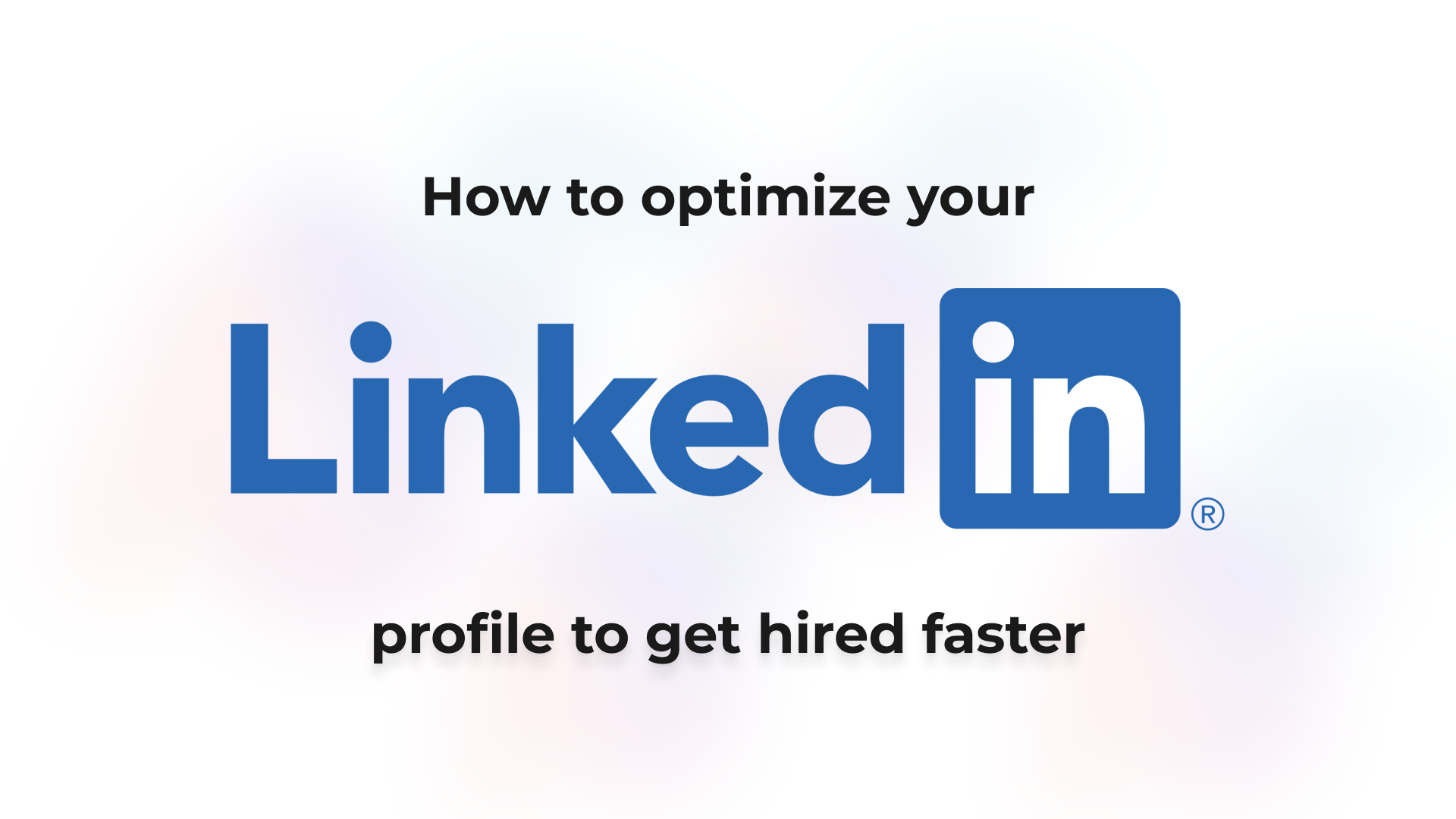
How to optimize your LinkedIn profile in 2025 and find a job faster
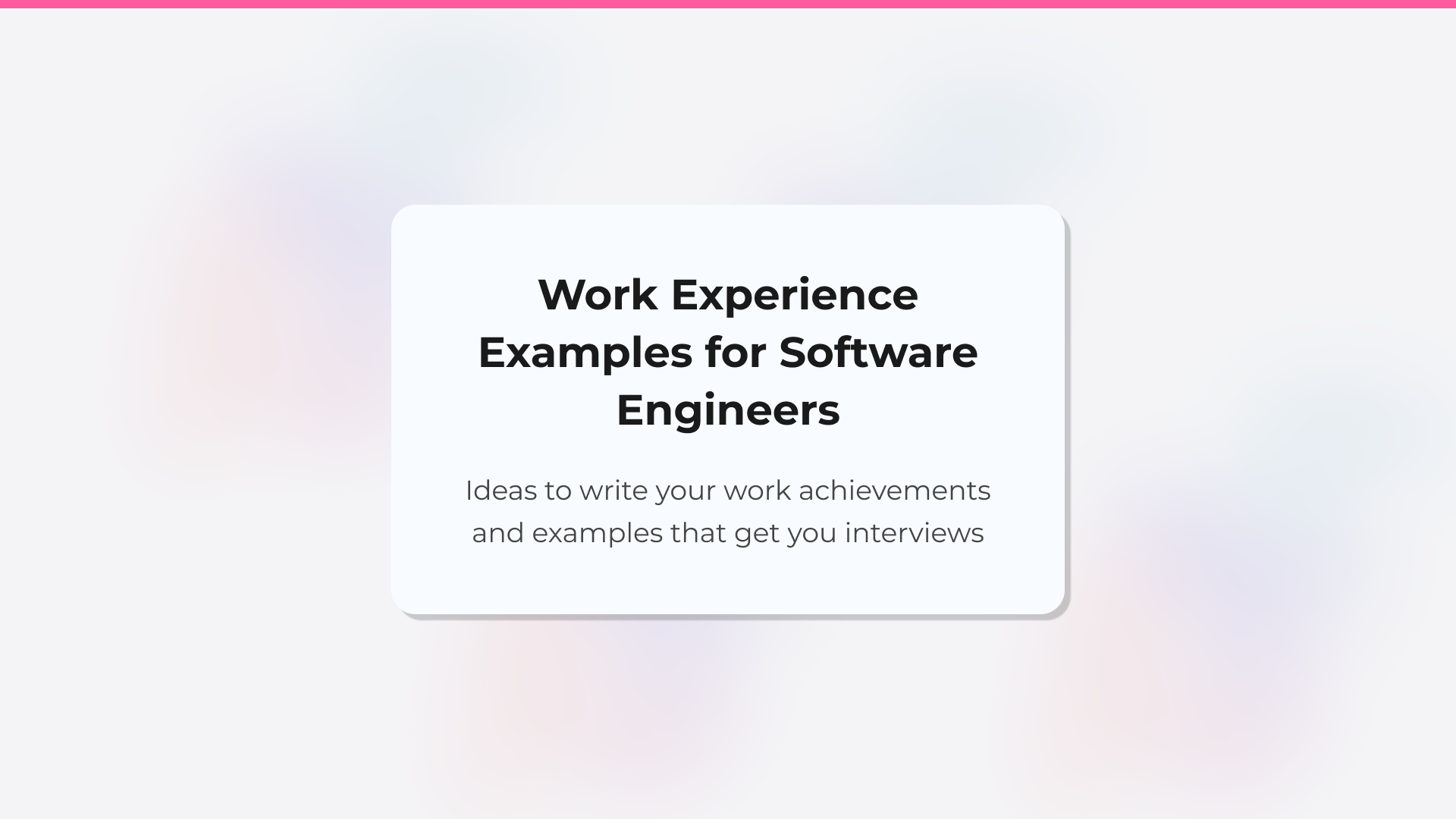
Software engineer resume: work experience and achievements examples
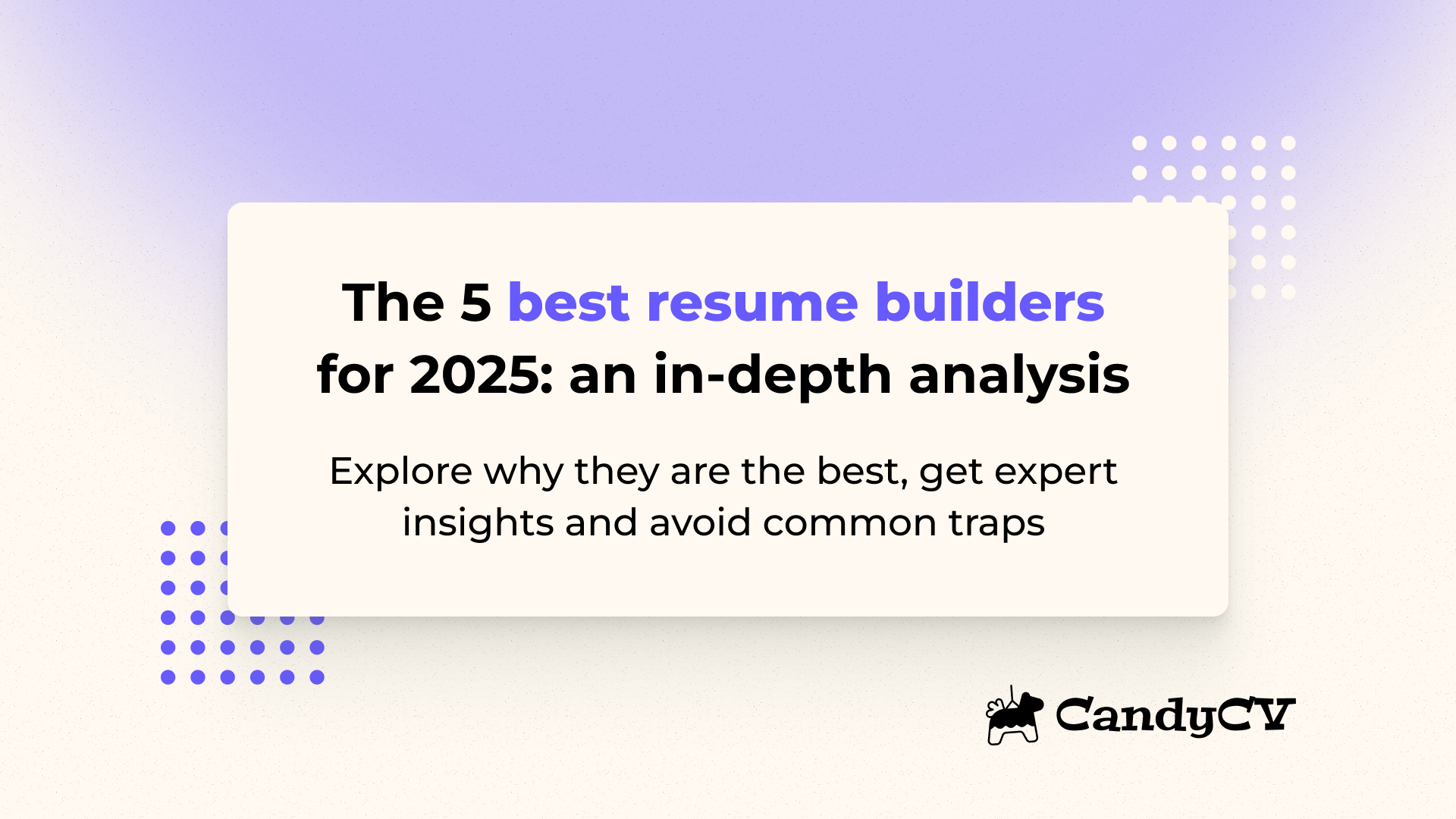
Top 5 resume builders: comparison and how to choose the best one
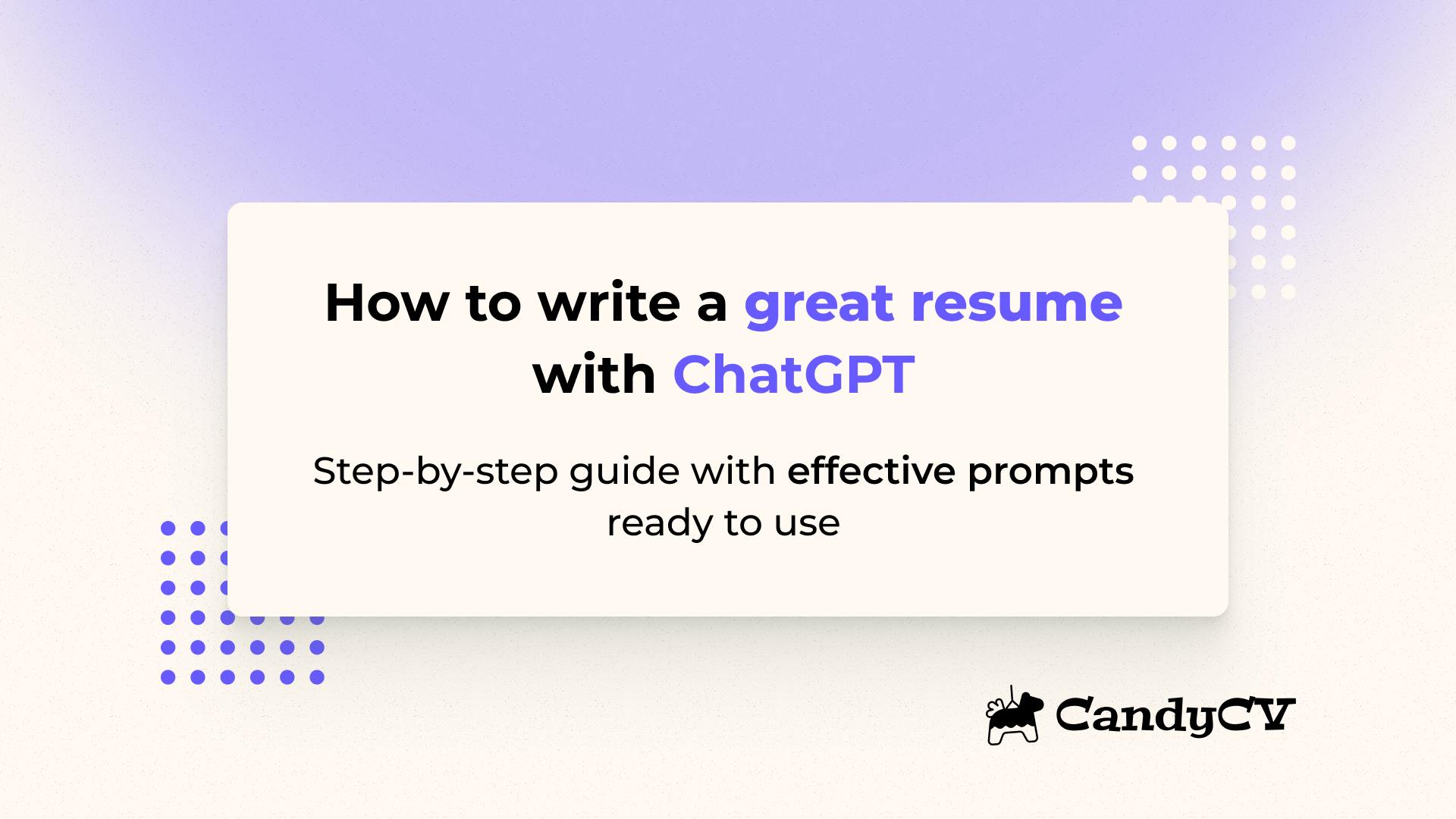
How to create a resume with ChatGPT: step-by-step guide with effective prompts

Free Word resume templates: why you shouldn't use them (and the best alternative)
